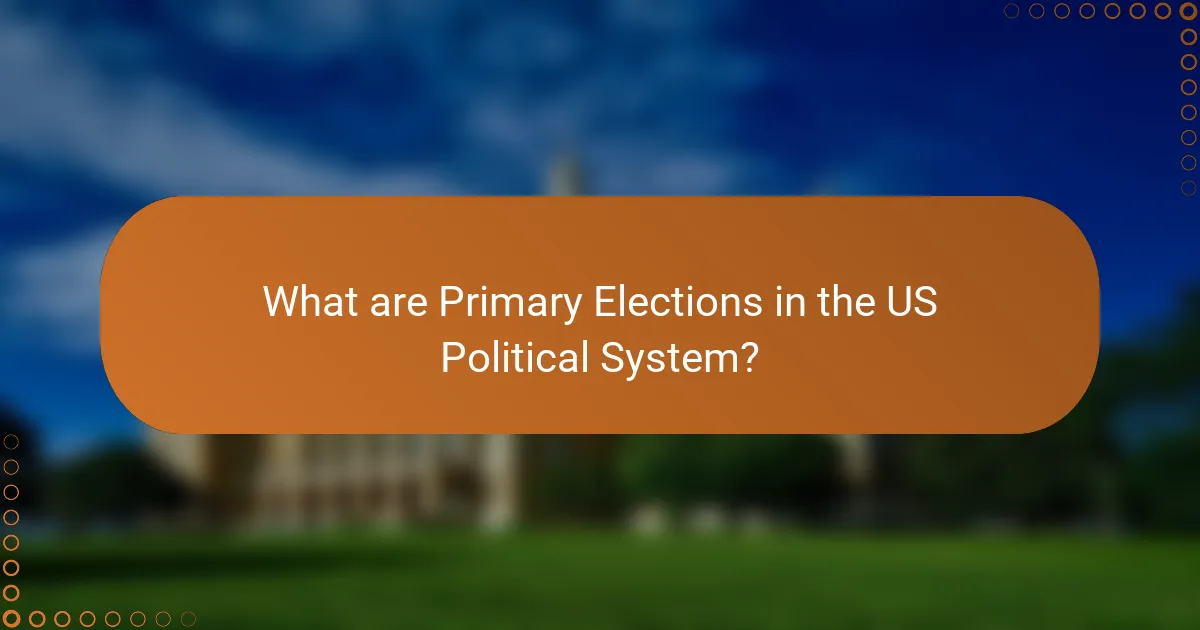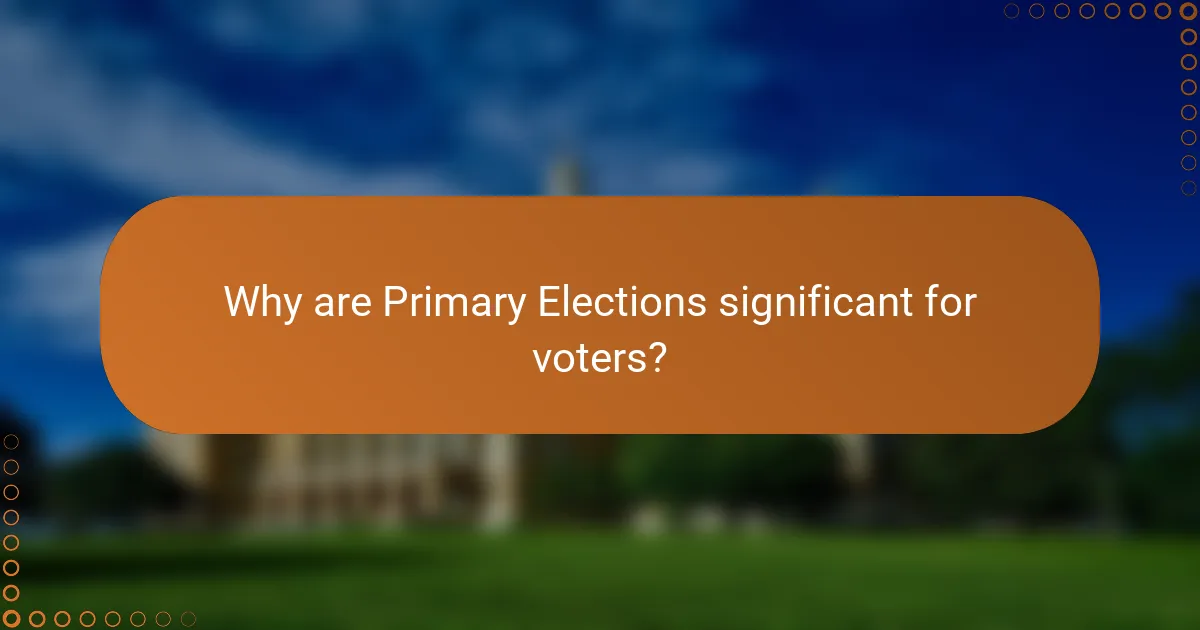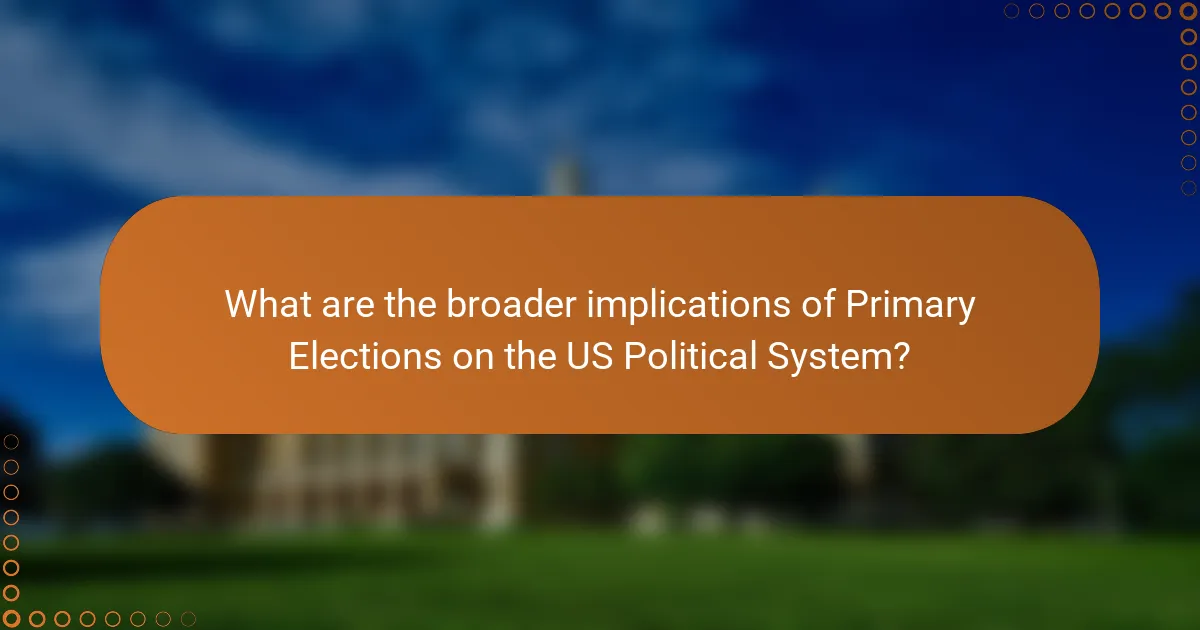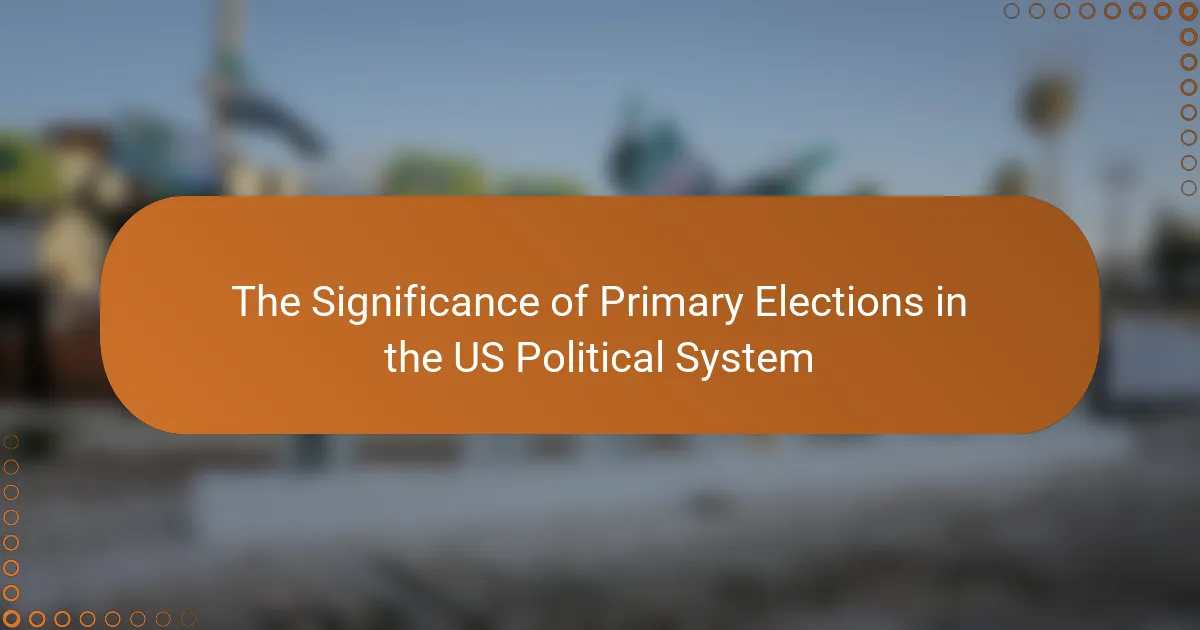Primary elections are preliminary elections in the United States political system that determine party candidates for the general election. These elections can be classified as open, closed, or semi-closed, impacting voter participation based on party affiliation. Primary elections are crucial for gauging voter support, shaping party platforms, and influencing candidate momentum, particularly in early events like the Iowa caucus and New Hampshire primary. Voter engagement in these elections is vital, as it directly affects the selection of nominees and reflects broader political trends and shifts in voter priorities. The outcomes of primary elections can also lead to divisions within parties, impacting overall party unity and governance.

What are Primary Elections in the US Political System?
Primary elections in the US political system are preliminary elections held to determine a party’s candidate for the general election. These elections can be open, closed, or semi-closed, affecting who can vote in them. In a closed primary, only registered party members can vote. Open primaries allow any registered voter to participate, regardless of party affiliation. Primary elections serve to gauge voter support for candidates and help narrow the field. They are critical in shaping the political landscape and influence the selection of nominees. For example, the Iowa caucus and New Hampshire primary are significant early events in the election cycle. These events can impact candidate momentum and fundraising efforts.
How do Primary Elections differ from General Elections?
Primary elections select candidates for the general election. They determine which candidates will represent a political party. General elections decide which candidates will hold office. Primary elections can be open or closed, affecting voter participation. Closed primaries restrict voting to registered party members. General elections are typically open to all eligible voters. The primary process can vary by state, influencing the selection method. General elections occur on a set date, usually the first Tuesday after the first Monday in November.
What types of Primary Elections exist in the US?
There are several types of primary elections in the US. The main types are closed, open, and semi-closed primaries. Closed primaries require voters to be registered with a party to vote in that party’s primary. Open primaries allow any registered voter to participate, regardless of party affiliation. Semi-closed primaries permit unaffiliated voters to choose which party’s primary to vote in while restricting party members to their own party’s primary. These distinctions influence voter participation and candidate selection in the electoral process.
Why are Primary Elections important for political parties?
Primary elections are important for political parties because they determine the candidates who will represent the party in general elections. These elections allow party members to express their preferences and influence the selection process. They also serve to mobilize voters and engage the party base. In 2020, for example, over 50 million voters participated in Democratic primaries, showcasing the significance of these elections. Additionally, primary elections help parties gauge public support for their policies and candidates. This feedback can inform campaign strategies and platform adjustments. Overall, primary elections are a crucial mechanism for candidate selection and party unity.
What role do Primary Elections play in candidate selection?
Primary elections serve as a mechanism for selecting party nominees for general elections. They allow registered party members to vote on candidates who will represent their party. This process narrows the field of candidates, ensuring that only those with sufficient support advance. In 2020, for example, Joe Biden secured the Democratic nomination through a series of primary elections across multiple states. Primary elections can be open, closed, or semi-closed, affecting who can participate. They play a crucial role in determining party platforms and voter engagement. Thus, primary elections are essential for shaping the electoral landscape in the United States.
How do Primary Elections influence voter engagement?
Primary elections significantly influence voter engagement by determining candidates for general elections. They create a competitive environment that motivates voters to participate. High-profile primaries often attract media attention, which raises public awareness. Increased awareness can lead to higher voter turnout. For instance, the 2020 Democratic primary saw a turnout increase of 10% compared to 2016. Additionally, primaries allow voters to express their preferences early in the election process. This early engagement can foster a sense of ownership in the electoral outcome. As a result, voters may feel more invested in the candidates and issues. Ultimately, primary elections serve as a catalyst for broader civic participation.
What impact do Primary Elections have on party unity?
Primary elections can significantly impact party unity. They often create divisions within the party as candidates compete for the nomination. This competition can lead to ideological rifts and factionalism. For example, the 2016 Democratic primary saw tensions between establishment and progressive factions. Such divisions can weaken the party’s overall cohesion leading into the general election. According to a 2020 study by the Pew Research Center, primary contests can polarize party members and affect their willingness to support the eventual nominee. Ultimately, the impact of primary elections on party unity depends on the nature of the competition and the candidates involved.

Why are Primary Elections significant for voters?
Primary elections are significant for voters because they determine which candidates will represent their party in the general election. These elections allow voters to have a direct say in the selection of candidates. By participating, voters influence party platforms and policies. Primary elections also engage citizens in the political process, fostering greater political awareness. According to the U.S. Census Bureau, voter turnout in primaries can be lower than in general elections, highlighting the importance of participation. Engaging in primaries helps ensure that the candidates reflect the voters’ preferences. This process ultimately shapes the electoral landscape and impacts governance.
How do Primary Elections empower voters in the political process?
Primary elections empower voters by giving them the opportunity to select their preferred candidates for the general election. This process allows voters to influence party nominations directly. In many states, primary elections are open to all registered voters, enhancing participation. Voter engagement increases as individuals feel their choices matter. Historical data shows that higher voter turnout in primaries correlates with more competitive general elections. Additionally, primary elections provide a platform for diverse candidates to emerge. This fosters a broader representation of ideas and policies within political parties. Overall, primary elections are crucial for enhancing democratic participation and accountability in the political process.
What are the implications of voter turnout in Primary Elections?
Voter turnout in primary elections significantly impacts the political landscape. High turnout often leads to a more representative selection of candidates. It reflects broader public engagement and interest in the electoral process. Conversely, low turnout can skew results toward more extreme candidates. This is because dedicated voters may hold more extreme views than the general electorate. Historical data shows that states with higher primary turnout often see candidates who align more closely with the majority of voters in the general election. For instance, in the 2020 Democratic primaries, states with higher turnout favored more moderate candidates, influencing the party’s direction. Thus, voter turnout is crucial for ensuring that primary elections reflect the will of the electorate.
How can voters participate effectively in Primary Elections?
Voters can participate effectively in Primary Elections by registering to vote ahead of the election date. Each state has its own registration deadline, often weeks before the election. Voters should check their registration status to ensure they are eligible to vote. Understanding the primary system in their state is crucial. Some states have open primaries, while others have closed ones. Voters must know which candidates are running in their party’s primary. Researching candidates’ positions and past performance can inform their choices. Voting on election day or utilizing early voting options increases participation. Engaging in discussions and encouraging others to vote can amplify their impact.
What challenges do Primary Elections present to candidates?
Primary elections present several challenges to candidates. One significant challenge is the need for substantial fundraising. Candidates must secure financial resources to compete effectively. Limited funding can hinder outreach and campaign efforts. Additionally, candidates face intense competition from within their party. This competition can lead to divisive primaries, impacting overall party unity. Another challenge is voter turnout, which is often lower in primaries compared to general elections. Low turnout can skew results, making it difficult for candidates to gauge support. Furthermore, candidates must navigate party rules and regulations, which can vary widely. These rules can impact ballot access and delegate allocation. Lastly, candidates often struggle with media scrutiny and public perception. Negative coverage can damage reputations and derail campaigns.
How do fundraising and resources affect success in Primary Elections?
Fundraising and resources significantly impact success in primary elections. Candidates with higher fundraising totals can afford more extensive campaign strategies. This includes hiring skilled staff, purchasing advertising, and organizing events. A study by the Center for Responsive Politics shows that candidates who raise more money tend to win their primaries. For example, in the 2020 Democratic primary, candidates who raised over $1 million had a higher likelihood of securing delegate support. Additionally, resources enable candidates to reach a broader audience and engage voters effectively. Overall, adequate fundraising and resources are critical for gaining visibility and support in primary elections.
What strategies do candidates use to appeal to primary voters?
Candidates use various strategies to appeal to primary voters. They often focus on specific issues that resonate with the party’s base. For instance, candidates may emphasize healthcare, immigration, or economic policies aligned with voter preferences. They also engage in grassroots campaigning to build local support. This includes door-to-door canvassing and attending community events. Candidates frequently utilize social media to connect with younger voters. They tailor their messaging to reflect the values and concerns of primary voters. Polling data helps candidates refine their strategies and target key demographics. Historical examples show that candidates who effectively engage with primary voters often secure their party’s nomination.

What are the broader implications of Primary Elections on the US Political System?
Primary elections significantly influence the US political system by shaping party candidates and voter engagement. They determine which candidates will represent their parties in general elections. This process can lead to the nomination of candidates who align closely with party bases. A study by the Pew Research Center indicates that primary elections often mobilize voters, increasing overall political participation. Additionally, they can create divisions within parties, as seen in the 2016 Republican primaries. Such divisions may affect party unity in general elections. The outcomes of primary elections can also signal broader political trends and shifts in voter priorities. Historical patterns show that primary results can impact policy directions and party strategies moving forward.
How do Primary Elections shape party platforms and policies?
Primary elections significantly shape party platforms and policies by determining the candidates who will represent the party in general elections. The candidates’ positions and platforms are influenced by the preferences of primary voters. These voters often have specific ideological leanings that can push candidates to adopt more extreme or specific policy positions. For instance, candidates may emphasize certain issues to appeal to their base during the primaries.
Once a candidate secures the nomination, they often solidify their platform to attract a broader electorate. This process can lead to compromises or shifts in policy to unify party members. Historical examples include the 2016 Republican primaries, where candidates adjusted their policies based on voter sentiment.
Ultimately, primary elections act as a filter, shaping the policy agenda of parties based on the outcomes of these contests. The resulting platforms reflect the collective preferences of party members and influence the party’s strategy in the general election.
What role do Primary Elections play in the evolution of political ideologies?
Primary elections play a crucial role in shaping political ideologies by allowing voters to select candidates who align with their beliefs. This process encourages candidates to adopt positions that resonate with their party’s base. As candidates compete in primaries, they often shift their platforms to appeal to more ideologically extreme voters. This phenomenon can lead to the solidification of specific ideological factions within the party. For instance, the rise of the Tea Party influenced the Republican Party to adopt more conservative stances. Similarly, the progressive movement has pushed the Democratic Party to embrace more liberal policies. Over time, primary elections can redefine party identities and influence national discourse on key issues. The outcomes of these elections reflect the evolving priorities and values of the electorate.
What are the future trends and reforms related to Primary Elections?
Future trends in primary elections include increased use of technology, such as online voting and blockchain for security. These innovations aim to enhance voter participation and streamline the voting process. Reforms are also focusing on reducing the influence of money in politics. This includes implementing stricter campaign finance laws and promoting public funding for candidates.
Another trend is the movement towards open primaries. This allows unaffiliated voters to participate, potentially increasing voter turnout. Additionally, there is a push for ranked-choice voting in primaries. This method can provide a more accurate reflection of voter preferences and reduce negative campaigning.
Moreover, states are considering reforms to the timing of primaries. Some aim to hold primaries earlier to increase their relevance in the nomination process. These trends and reforms reflect a growing emphasis on accessibility, fairness, and engagement in the electoral process.
How might changes in Primary Election processes affect voter participation?
Changes in Primary Election processes can significantly affect voter participation. For instance, implementing open primaries may increase participation by allowing unaffiliated voters to cast ballots. Research indicates that states with open primaries often see higher turnout rates. Conversely, closed primaries can limit participation to registered party members, potentially reducing overall voter engagement. Additionally, changes in voting methods, such as transitioning to mail-in ballots, can also boost participation by making it more accessible. Historical data shows that states that adopted mail-in voting saw an increase in voter turnout during primaries. Overall, the structure and rules governing primary elections play a crucial role in influencing voter involvement.
What best practices can enhance the effectiveness of Primary Elections?
Implementing ranked-choice voting can enhance the effectiveness of primary elections. This method allows voters to rank candidates in order of preference. It can lead to more representative outcomes by reducing the impact of vote-splitting. Studies show that ranked-choice voting increases voter engagement and satisfaction. Additionally, ensuring transparency in the electoral process is crucial. Clear communication about rules and procedures fosters trust among voters.
Improving accessibility for all voters is another best practice. This includes providing multiple voting methods, such as mail-in ballots and early voting. Research indicates that increased access correlates with higher voter turnout. Finally, investing in voter education campaigns can significantly enhance participation. Educated voters are more likely to engage in the electoral process, leading to more informed decision-making.
Primary elections in the US political system are essential preliminary elections that determine party candidates for the general election. They can be categorized as closed, open, or semi-closed, significantly influencing voter participation and candidate selection. The article explores the differences between primary and general elections, the importance of primary elections for political parties and voters, the impact on party unity, and the implications of voter turnout. Additionally, it discusses the challenges candidates face, strategies for appealing to primary voters, and future trends and reforms related to primary elections.
